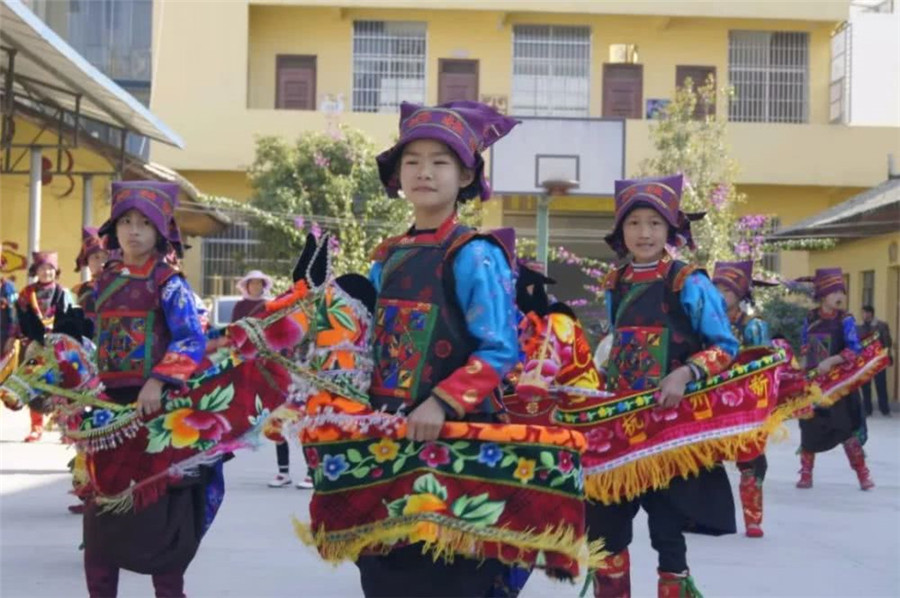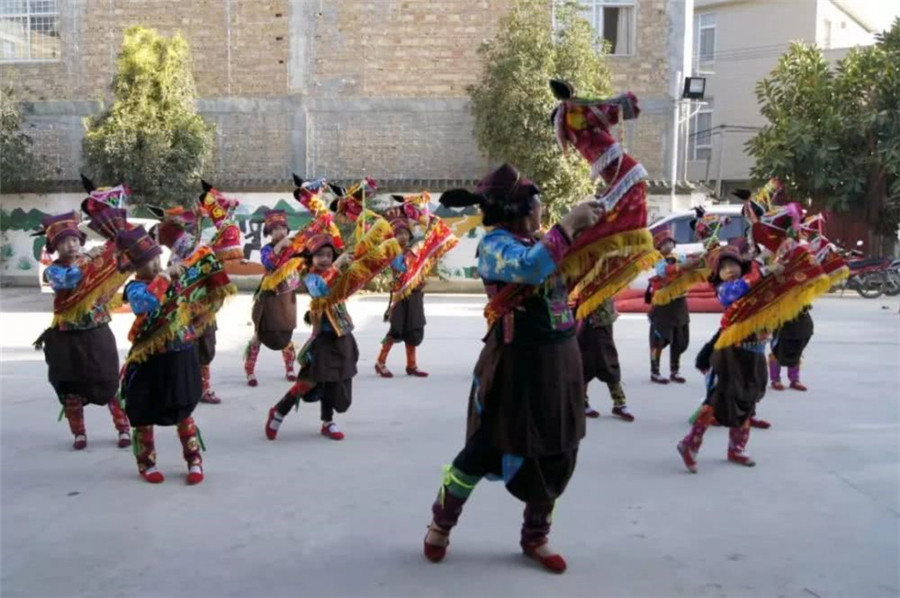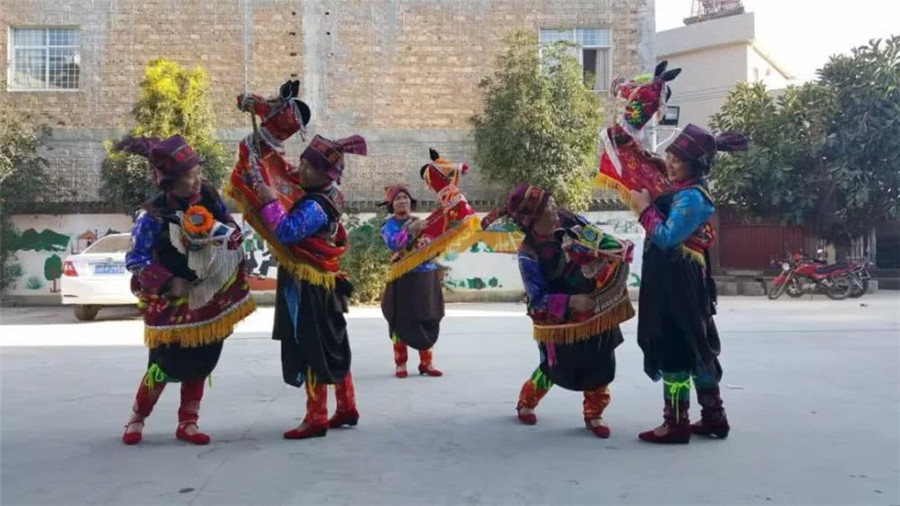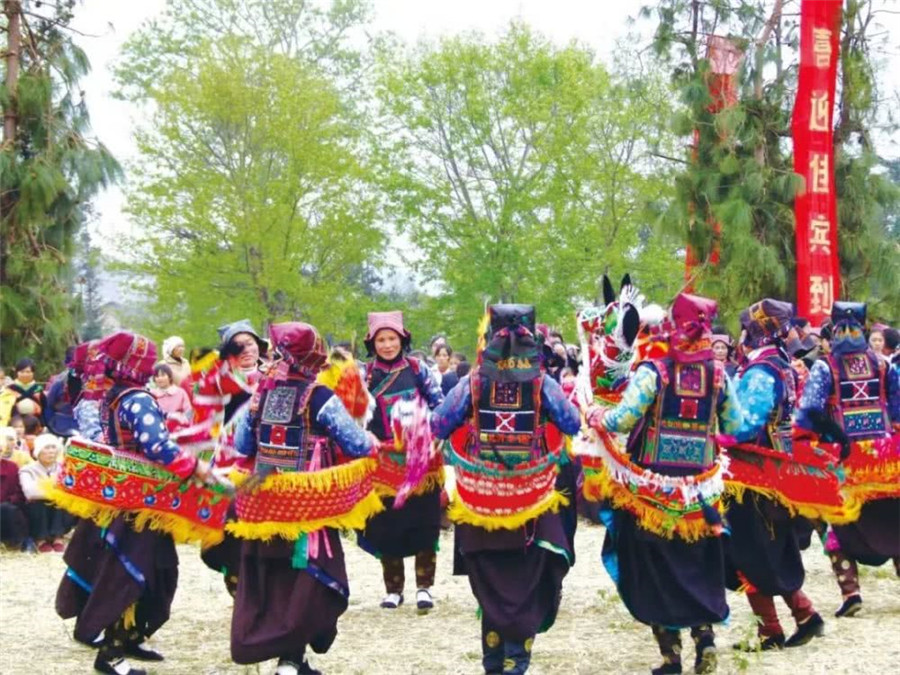Dance Form
The Paper Horse has a head, eyes, ears, mouth, body, and tail, but no legs. Before the dance, the dancer enters through the hollow belly of the paper horse, placing it around their waist while holding the horse’s sides with both hands to perform the dance. The basic movement involves jumping on one foot and landing on both feet. When the left foot jumps, the right foot steps diagonally to the left front, and when the right foot jumps, the left foot steps diagonally to the right front. On the third beat, the dancer must also tap the ground with the stepping hand twice. When dancing in a circle, the dancer wearing the ghost mask should coordinate with the dancers before and after them, ensuring that the movements of the left and right feet and steps are in sync. In the dance, the horses face each other, the lions face the handkerchief, the ghosts face the small knives, and the large knives face each other, engaging in mock combat. The dancer performing the Paper Horse must also follow the steps and rhythm, rocking the horse’s head from side to side in time, making the two “horses” appear to bite, kick, and fight each other. The sound of the bells rings loudly as dust is kicked up, creating an atmosphere similar to a battlefield.
As the bells, drums, gongs, and mortar sounds ring out in unison, the dancers continuously shake the horse’s head, kicking, jumping, and turning; it is as if the horse is raising its head, wagging its tail, and lifting its hooves, sometimes neighing as it raises its hooves, and at other times galloping forward with force. The lion bearer rolls forward and backward, swaying left and right, jumping high, while the knife bearers perform stabbing, slashing, and chopping movements. The scene is impressive, with the dance’s movements being ancient and vigorous, captivating all who watch.
In Maguan County, Zhuang ethnic people typically perform the Paper Horse Dance with one or two dancers. The dancers hold the paper horse at their waist with both hands while dancing around the coffin of the deceased. The movements primarily involve shaking, kicking, jumping, and turning, mimicking the posture of a horse raising its head, wagging its tail, and kicking its hooves as they dance in a circle.
In Kaohua Town, Wenshan Zhuang and Miao Autonomous Prefecture, the Paper Horse Dance is performed by women wearing traditional Zhuang clothing. The dance has been passed down through generations, with each generation having its own representative figures known for their high-level skills. Currently, the recognized masters include Gao Shaoying and He Yongqiong from Niutou Village, though the latter has stopped performing due to old age. The Zhuang Paper Horse Dance in Kaohua Town has participated in numerous cultural performances at the provincial, county, and town levels, and has been frequently covered by media outlets. The dance is also included in the Collection of Yunnan Ethnic and Folk Dances.
Theme of the Performance
The Paper Horse Dance primarily portrays the themes of driving away evil spirits and calming souls. The movements are intense and vigorous, with a strong focus on mimicry. The dance primarily imitates the running, jumping, hoof kicking, biting, and neighing of horses. Meanwhile, the smiling monks use various methods to tease the lion, while two small ghosts intersperse themselves among the dancers, causing mischief and amusement. The warriors wield weapons, chasing and hunting down the ghosts, continuing the dance until the ghosts are driven away, the lion is exhausted and collapsed, and the paper horse is caught. Only then does the dance come to an end.
Value
The Paper Horse Dance is a concentrated expression of the Zhuang people’s ancestral worship, reflecting the funeral and sacrificial customs of the Zhuang ancestors and traditional dance forms. Its form and development process reflect the historical changes in Zhuang society and hold significant value for the study of Zhuang history, culture, and artistic development. Today, the Paper Horse Dance has integrated elements of sports, entertainment, leisure, education, and religious rituals. It both celebrates ethnic traditions and embraces changes, making it widely popular among the people. The dance is spiritually evocative, vigorous, and natural, yet also graceful and subtle; it interprets history with depth, richness, and expansiveness; it is passionate and bright, yet also calm and gentle. The dance embodies both artistic beauty and natural inspiration.
Yunnan’s folk culture is rich in intangible cultural heritage, and the Paper Horse Dance has been recognized as such. It reflects the history of Zhuang culture in Yunnan, fully embodying the original ethnic sports culture, daily life, customs, and rituals of the minority people. The Paper Horse Dance is continuously growing, moving from villages to stages, and from stages to broader cultural exchange platforms. Through learning, innovation, inheritance, and promotion, it has been refined, improved, and elevated.
Current Situation
The original funerary and sacrificial nature of the Paper Horse Dance has evolved into a form of group entertainment, with fundamental changes occurring in both its content and form. The traditional dance form now faces a heritage crisis and urgently needs effective protection. Many Zhuang villages in Kaohua Town, Wenshan County, have established their own Paper Horse Dance troupes, each with its own leader or Paper Horse Dance master.
In 2006, the Paper Horse Dance of Kaohua Town and the town itself as the “Hometown of Paper Horse Dance” were included in the first batch of intangible cultural heritage items listed for protection by Yunnan Province. In 2007, the Zhuang “Paper Horse Dance” was approved by the Provincial Department of Culture and submitted to the Ministry of Culture of the People’s Republic of China for inclusion in the second batch of national intangible cultural heritage.

 7 Days GolfingTour
7 Days GolfingTour
 8 Days Group Tour
8 Days Group Tour
 8 Days Yunnan Tour
8 Days Yunnan Tour
 7 Days Shangri La Hiking
7 Days Shangri La Hiking
 11 Days Yunnan Tour
11 Days Yunnan Tour
 6 Days Yuanyang Terraces
6 Days Yuanyang Terraces
 11 Days Yunnan Tour
11 Days Yunnan Tour
 8 Days South Yunnan
8 Days South Yunnan
 7 Days Tea Tour
7 Days Tea Tour
 8 Days Muslim Tour
8 Days Muslim Tour
 12 Days Self-Driving
12 Days Self-Driving
 4 Days Haba Climbing
4 Days Haba Climbing
 Tiger Leaping Gorge
Tiger Leaping Gorge
 Stone Forest
Stone Forest
 Yunnan-Tibet
Yunnan-Tibet
 Hani Rice Terraces
Hani Rice Terraces
 Kunming
Kunming
 Lijiang
Lijiang
 Shangri-la
Shangri-la
 Dali
Dali
 XishuangBanna
XishuangBanna
 Honghe
Honghe
 Kunming
Kunming
 Lijiang
Lijiang
 Shangri-la
Shangri-la
 Yuanyang Rice Terraces
Yuanyang Rice Terraces
 Nujiang
Nujiang
 XishuangBanna
XishuangBanna
 Spring City Golf
Spring City Golf
 Snow Mountain Golf
Snow Mountain Golf
 Stone Mountain Golf
Stone Mountain Golf
















